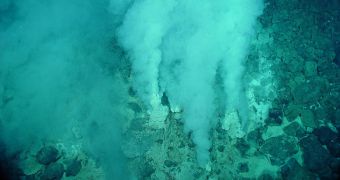Investigators at the Harvard University announce the discovery of a naturally-occurring battery at the bottom of the Pacific Ocean. The construct is powered up by microorganisms that live near and around structures called hydrothermal vents.
These are locations in the Earth's crust from which hot gases are vented out of the planetary mantle. Many theories on the origins of life here suggest that the earliest single-celled organisms first appeared around these structures.
Microbes form structures resembling chimneys as they come together in large colonies. Over time, these cities have grown to impressive sizes, and now researchers discover that electrical current is flowing through their walls, Science News reports.
The electricity is produced as the organisms consume the dangerous chemicals that are evicted through the vents. “The amount of power produced by these microbes is rather modest. But you could technically produce power in perpetuity,” Harvard biologist and engineer Peter Girguis explains.

 14 DAY TRIAL //
14 DAY TRIAL //